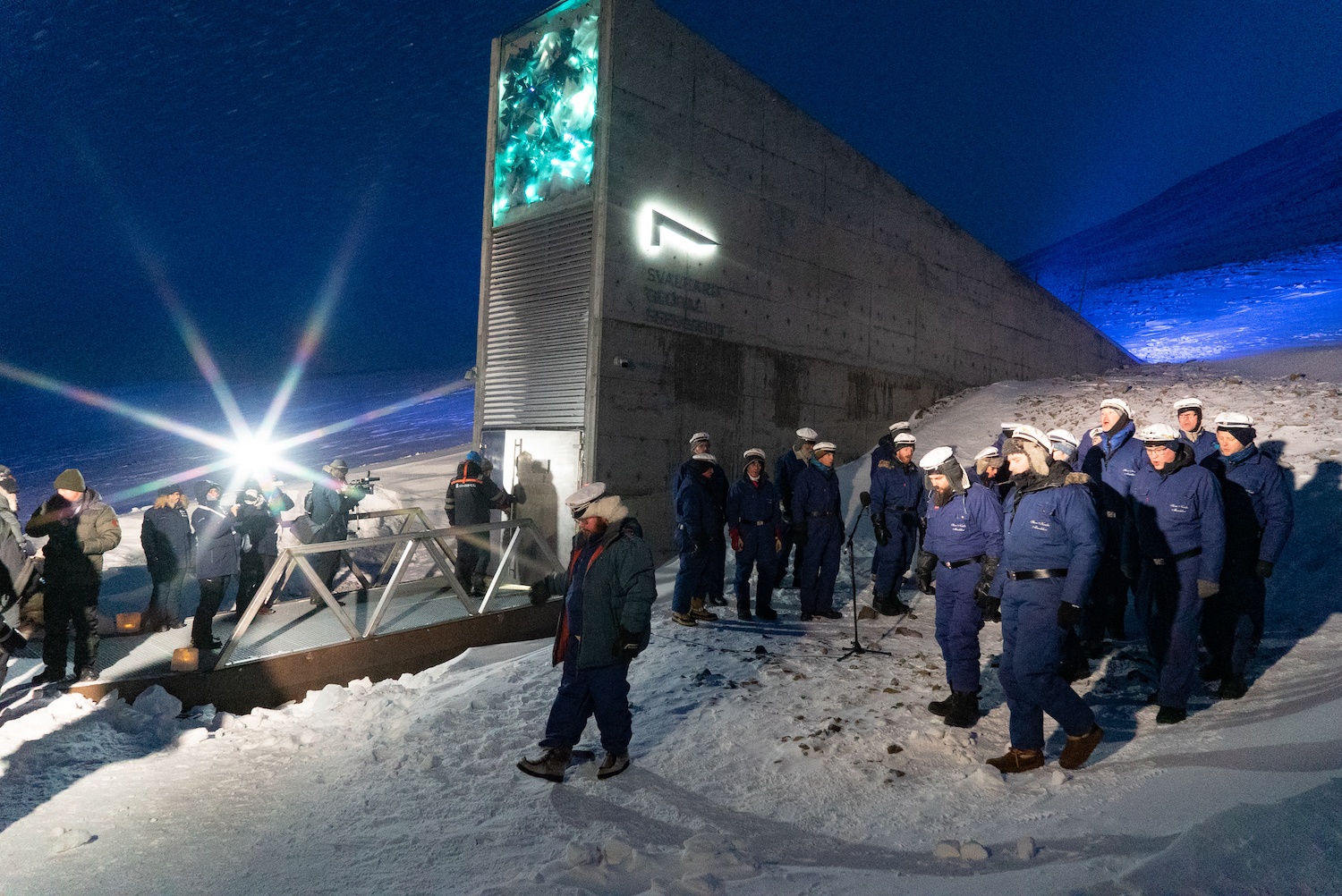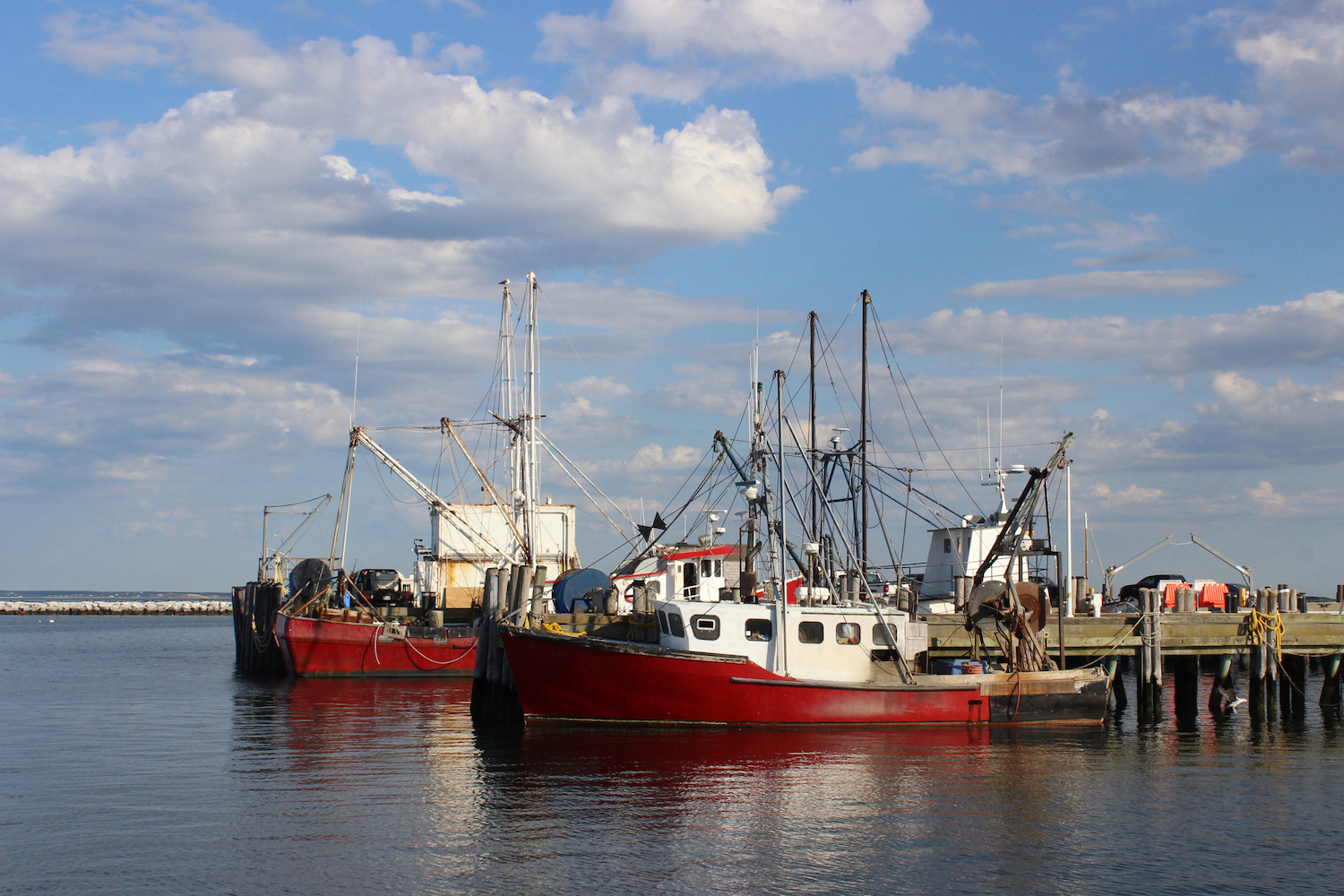
Lance Cheung/USDA
Improving gene bank databases could prove critical to global food security in the coming years. Whether we’re prepared to use newly available data effectively is another question.
Pictured above: The U.S. Department of Agriculture’s (USDA) Agriculture Research Service (ARS) National Center for Genetic Resources Preservation (NCGRP) National Plant Germplasm System (NPGS) cold storage vault, in Ft. Collins, Colorado. The long-term storage facility contains nearly one million samples of more than 13,200 plant species.
An efficient way for a person to procrastinate for many hours is to noodle around in the U.S. National Plant Germplasm System (NPGS). The NPGS is a vast online database, a version of which first went into use in 1983, cataloging all the seeds and other germplasm collected and housed in USDA gene banks in the interest of bolstering our food and environmental security. More than just a resource for the bored and immature to snicker over species of fern collected from Texas’s “wet, seeping bogs,” or apples with names like “Brown Snout” and “Bogo Belle de Boskoop,” the NPGS allows scientists like Cornell University pea and pepper breeder Michael Mazourek, who frequently sources from the database to find materials that help him develop crop plants that are resistant to the diseases, pests, and variable chaos being loosed on Earth’s flora by climate change.
Crops, points out Georgia Eizenga, a research geneticist at the USDA’s rice research center in Stuttgart, Arkansas, are “adapted to a given environment…and when you start changing that”— as happens with intensifying storms and soils made saltier from sea level rise, for example—“you need broader [genetic] coverage.” One way to get this sort of coverage is by going back into a gene bank and finding accessions (simply, the acquired plant materials in a collection) to expand the breeding pool.
But various scientists say the information in the NPGS is insufficient, out-of-date, and in some cases, lacking relevant data that would help determine their usefulness. Researchers at the USDA and gene banks around the world are aiming to fix that. They’re genotyping accessions: analyzing their DNA to determine their particular traits to help increase available data and make the NPGS database more user-friendly.

Researchers at the USDA and gene banks around the world, like Susan McCouch’s lab at Cornell, are analyzing DNA to determine particular traits to help increase available data and make the NPGS database more user-friendly.
Lela Nargi
A gene bank’s database is most effective when it can provide relevant details about what’s in its collection. A library catalog that tells you a book’s title and author is off to a fine start; whether the book is fiction or nonfiction, its length, a description of its basic plot, though, are what ultimately convince a reader whether to yank it off the shelf.
The same goes with the NPGS database, which is actually part of a growing, worldwide network of gene bank databases called the Germplasm Resource Information Network, or GRIN-Global. Type in “Oryza” and up will come a list of the 19,000-plus accessions of rice in the USDA’s archive, where they came from, and how much of them exists in the collection. That’s a fine informational start—as is the accompanying phenotypical data that makes note of certain physical attributes: how many days till a plant “heads,” how tall it grows, what color its awns are. This used to be all that existed to help a researcher decide if an accession was worth ordering out of the vault.
“For many species, it’s pretty overwhelming to go to the national germplasm system and try to select from tens of thousands of accessions—where do you start?” said Patrick Byrne, a professor emeritus of plant breeding and genetics at Colorado State University who specializes in wheat. “Whatever can be done to make germplasm collections more accessible and useful to breeders, and to help them narrow down what to request, is going in a positive direction.”
“Most things in a gene bank are far behind in terms of performance from what breeders are producing and releasing.”
But even with consensus that improved database information could prove critical to global food security in coming years and decades, there’s debate about how much improvement is too much, too soon—especially as our technological capabilities expand, perhaps more rapidly than is immediately useful.
For over 100 years, 25 rice accessions have been used to develop the elite breeding lines that, even now, create the parents of new cultivars that grow well in the Southern Rice Belt around the Lower Mississippi River and Gulf Coast. “That puts us in a vulnerable position,” said Eizenga. For food safety’s sake, she wants to double the number of accessions in that breeding pool.
To that end, in 2015, she and colleagues started genotyping some 2,000 rice accessions by analyzing bits of their DNA using microsatellite, or Simple Sequence Repeat (SSR), markers. In addition to other meaningful findings, they identified markers on four major genes that are associated with blast—a fungal disease that causes a 10 to 30 percent loss of the global rice crop every year.

Because of its small genome size, rice is the easiest of the world’s major crops to analyze.
Lela Nargi
It’s useful technology, albeit already a little antiquated. “They used primitive tools…[but] it’s what they had in-house, and they put it together in a catalog that’s already much better than what they had before,” said Susan McCouch, a Cornell rice breeder who developed, starting in 1995, much of the SSR technology the USDA researchers employed. (That data is still in the process of being categorized so it can be uploaded to NPGS.) “But many gene banks in the world are already using modern sequencing,” she added, and not just for rice—which, with its small genome size, is the easiest of the world’s major crops to analyze.
One of these is the Leibniz Institute of Plant Genetics and Crop Plant Research (IPK) in Germany, where researcher Martin Mascher used more sophisticated sequencing methods on the 22,000 barley accessions in IPK’s collection. “There’s no good reason to use this technology,” he said, dismissing the USDA’s more modest genotyping project. “It’s a waste of labor.” He points out that Eizenga and her colleagues were able to identify 29 rice markers in all. By contrast, IPK in some instances identified as many as 70,000 genetic markers on each of its barley accessions. Meanwhile, the International Rice Research Institute in the Philippines has already taken that up a notch, managing to sequence the entire genome for 3,000 of their over 13,000 rice accessions—a slow and costly process that’s out of reach for scientists like Eizenga.
Some breeders bristle at the idea of using unfamiliar and untested accessions, no matter how much genetic detail is available about them. That’s because they’ve often spent years honing “elite” breeding lines whose performance is well-known to them.
“Pre-breeders are less interested to develop a finished variety and more interested in discovering new genetic variety.”
“Most things in a gene bank are far behind in terms of performance from what breeders are producing and releasing,” Byrne explained. For example, crop wild relatives may have spent their time sitting in storage since they were collected out in the field. Breeders are “reluctant to bring in unadapted material unless it’s something really critical—like an insect-resistant gene—that they can’t find elsewhere,” he added.
But as McCouch pointed out, this is where pre-breeders, also known as bridge breeders, come in to “translate” an accession’s genetic potential into something a breeder can understand. Pre-breeders are more likely to search out an accession that genotyping shows is drought-tolerant, say, and use it to create a rough draft of a material that breeders could work into their own elite cultivars.
“Pre-breeders are less interested to develop a finished variety and more interested in discovering new genetic variety,” said Peter Wenzl, leader of the Genetic Resources Program at the Alliance of Biodiversity and International Center for Tropical Agriculture in Colombia, which is building a high-tech facility, called Future Seeds, that will interpret sequencing data from gene banks. “They’re a more curiosity-driven population, and they provide insights that can be picked up by breeders later on.”

A seed sample from Susan McCouch’s lab.
Lela Nargi
There are experts who say even this isn’t enough; that breeders and pre-breeders will need even more data to help them choose from among gene bank offerings, with futuristic phenotyping. A far cry from the more simplistic plant eye-balling of yore, this new, experimental phenotyping relies on drones, multispectral imaging, and instruments with names like the Videometer and the Germination Scanalyzer to evaluate seeds, roots, leaves, and other critical indicators of health and the environmental conditions that promote it.
Where the gene bank-using community previously experienced a dearth of relevant info, all this tech means it’s about to be pummeled with more raw data than it can immediately make sense of. Adam Famoso, an associate professor of rice breeding and genetics at the Louisiana State University AgCenter, explained that the infrastructure, in the form of intuitive databases, doesn’t yet exist to make that information graspable by potential end-users such as himself—although, places like Future Seeds are working to fix this.
Instead of rushing to generate “a huge amount of data that only a handful of people and programs can access, maybe we should wait until the technology improves and we have a clear plan for how to use it,” Famoso said. For him, the Eizenga team’s lower-tech efforts aren’t too little, or too much, but just right—for the moment.





